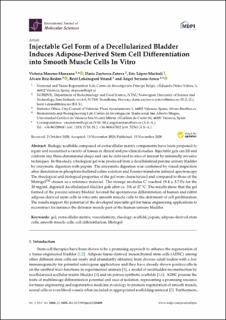| dc.contributor.author | Victoria, Moreno-Manzano | |
| dc.contributor.author | Zaitseva-Zotova, Daria | |
| dc.contributor.author | López-Mocholí, Eric | |
| dc.contributor.author | Briz-Redón, Álvaro | |
| dc.contributor.author | Strand, Berit Løkensgard | |
| dc.contributor.author | Serrano-Aroca, Angel | |
| dc.date.accessioned | 2021-03-02T14:41:40Z | |
| dc.date.available | 2021-03-02T14:41:40Z | |
| dc.date.created | 2021-01-26T22:48:51Z | |
| dc.date.issued | 2020 | |
| dc.identifier.citation | International Journal of Molecular Sciences. 2020, 21 (8608), 1-14. | en_US |
| dc.identifier.issn | 1422-0067 | |
| dc.identifier.uri | https://hdl.handle.net/11250/2731222 | |
| dc.description.abstract | Biologic scaffolds composed of extracellular matrix components have been proposed to repair and reconstruct a variety of tissues in clinical and pre-clinical studies. Injectable gels can fill and conform any three-dimensional shape and can be delivered to sites of interest by minimally invasive techniques. In this study, a biological gel was produced from a decellularized porcine urinary bladder by enzymatic digestion with pepsin. The enzymatic digestion was confirmed by visual inspection after dissolution in phosphate-buffered saline solution and Fourier-transform infrared spectroscopy. The rheological and biological properties of the gel were characterized and compared to those of the MatrigelTM chosen as a reference material. The storage modulus G’ reached 19.4 ± 3.7 Pa for the 30 mg/mL digested decellularized bladder gels after ca. 3 h at 37 °C. The results show that the gel formed of the porcine urinary bladder favored the spontaneous differentiation of human and rabbit adipose-derived stem cells in vitro into smooth muscle cells to the detriment of cell proliferation. The results support the potential of the developed injectable gel for tissue engineering applications to reconstruct for instance the detrusor muscle part of the human urinary bladder. | en_US |
| dc.language.iso | eng | en_US |
| dc.publisher | MDPI | en_US |
| dc.rights | Navngivelse 4.0 Internasjonal | * |
| dc.rights.uri | http://creativecommons.org/licenses/by/4.0/deed.no | * |
| dc.subject | gel; extracellular matrix; viscoelasticity; rheology; scaffold; pepsin; adipose-derived stem cells; smooth muscle cells; cell differentiation; Matrigel | en_US |
| dc.title | Injectable Gel Form of a Decellularized Bladder Induces Adipose-Derived Stem Cell Differentiation into Smooth Muscle Cells In Vitro | en_US |
| dc.type | Journal article | en_US |
| dc.type | Peer reviewed | en_US |
| dc.description.version | publishedVersion | en_US |
| dc.source.pagenumber | 1-14 | en_US |
| dc.source.volume | 21 | en_US |
| dc.source.journal | International Journal of Molecular Sciences | en_US |
| dc.source.issue | 8608 | en_US |
| dc.identifier.doi | 10.3390/ijms21228608 | |
| dc.identifier.cristin | 1879989 | |
| dc.relation.project | Norges forskningsråd: 269273 | en_US |
| cristin.ispublished | true | |
| cristin.fulltext | original | |
| cristin.qualitycode | 1 | |

